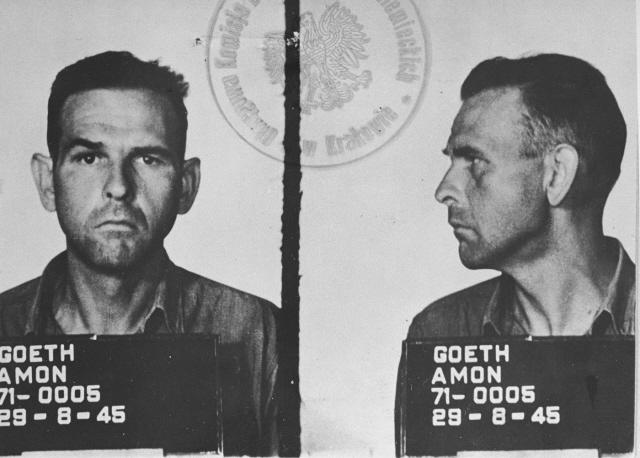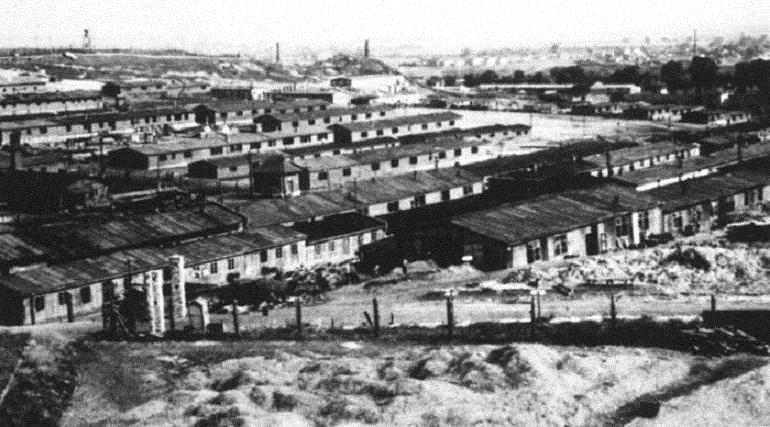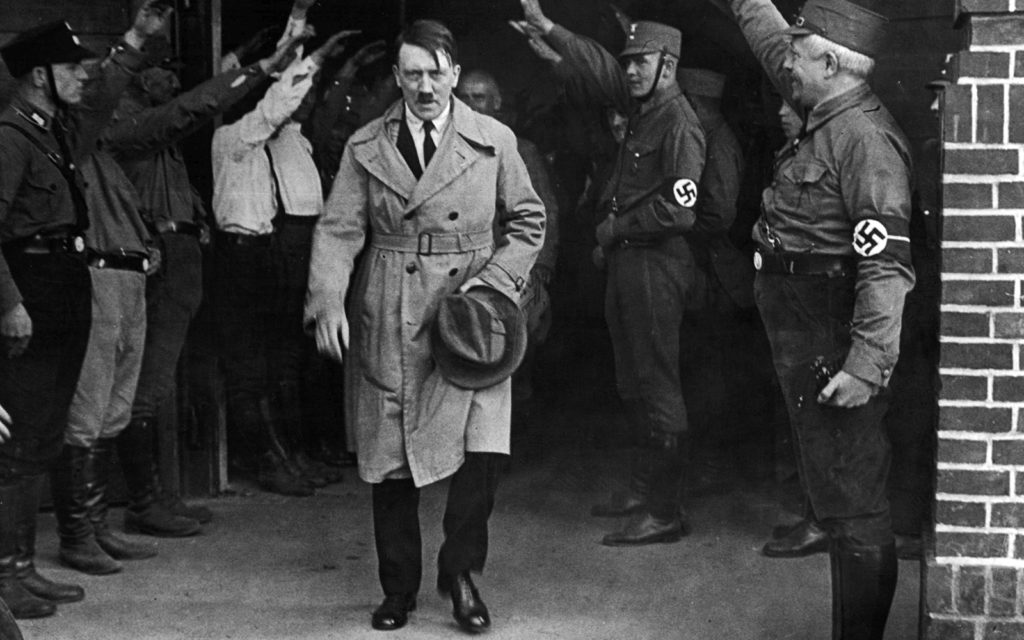When people first think of historical films about the Holocaust, arguably the most well-known one that would come to mind is Schindler’s List. This critically-acclaimed masterpiece is the most iconic film on the Holocaust ever produced.
Part of the reason why this film has gained such notoriety is undoubtedly because of the bestial nature of the camp’s commandant, Amon Göth. But who was Göth? Was he truly a sadistic killer or an over-dramatized archetypal villain?

Early Life and Career
Göth was born to an upper-middle-class family in Vienna in 1908. His family ran a successful publishing company in the city.
Because of this, his father was away on work trips, frequently drumming up new business while his mother stayed behind and managed the day-to-day affairs of the company. Other relatives often looked after Göth during his childhood and teenage years.
As a result, Göth grew up resenting his parents as he felt they had neglected him in place of their business. Having zero desire to enter his father’s publishing company, he instead developed a fond passion for all types of sports.
Upon graduating high school, the young Göth went off to study agriculture. He dropped out after several semesters and begrudgingly took up employment in the family business.
Göth did learn one lesson from college: his love of Nazism.
Göth would later claim college classmates radicalized him. Soon after going to college, he joined the Austrian branch of the Nazi party in 1925. During this time, the Nazi Party in Austria was starting to ramp up its terror campaign throughout the country.
Beatings, robberies, bombings, and murder were common calling cards of Nazis during this time. It is unclear if Göth also participated in these crimes directly. Still, it is a fact that he acted as a courier in bringing weapons, explosives, money, messages, and communications equipment into and out of Austria. It is even rumored that he had a part to play in the assassination of the Austrian Chancellor in 1934.
After this monumental event, the Austrian government cracked down on the Nazis. Thousands were arrested, including Göth. Fortunately for him, Austrian authorities soon released him, and he fled to Germany.
Once Hitler annexed the country, he returned to Austria. He continued to work in his father’s publishing business and openly carried out Nazi policies. By the time the war broke out, he already gained status as an “Old Guard” Nazi due to his joining the party in 1925. He had also joined the SS in 1930 and received full membership in 1933.
It is likely for this reason that he was chosen for his first assignment.
Making of a Murderer
When the war broke out, Göth was still working in Vienna. But as soon as the Fascist armies conquered Poland, he received a new assignment.
He proudly boasted in his personnel file that he was selected in early 1940 to serve in one of Himmler’s Sonderkommando units. His first posting was to Upper East Silesia in modern-day southwestern Poland. Here, he was taken under the wing of Albrecht Schmelt.
His duties here consisted of identifying and separating ethnic Germans from Jewish people. He would then move people around, assign work, round people up, and conduct the accounting for all Jewish labor.
Göth helped transform Schmelt’s forced labor force several times over. He helped generate so much money for Schmelt that he was able to send millions of Reichsmarks back to the government. Schmelt was also able to steal enough money to buy a mansion and 40,000 US dollars in currency.
These formative years created Göth’s transition into a monster. He became practiced in the murderous craft of enslaving and exploiting Jewish people and learned that murder could also be a business opportunity.
He helped Schmelt make large amounts of money and received high praise for it. This helped him get his next assignment. This is the assignment that would eventually catapult him into his tenure as Commandant of Płaszów.

Road to Commandant
Göth was introduced to Odilo Globocnik upon the recommendation of his commanding officer – Schmelt. He was the early architect of Operation Reinhard in Poland, the military designation for the Holocaust.
Göth was one of 450 hand-selected SS men chosen to help perpetrate the Holocaust in Poland. From 1942 to 1943, he was a trusted confidant of Globocnik tasked with carrying out the most brutal functions.
His SS record is still slightly unclear due to the secretive nature of Operation Reinhard. From eyewitness accounts, it is possible to piece together these formative six months.
He organized the deportation of Jewish people in the area. He ensured that the factories being run by slave labor were operating efficiently. He also had authority from Globocnik to personally have unhindered access to all three of the death camps operating at that time. He also personally requested that they report the statuses of each to his office.
Additionally, it is rumored that he helped pioneer gas chamber technology to make them deadlier and more efficient. Because of this and other crimes, he earned the nickname the Bloody Dog of Lublin.
Allegedly, due to disagreements between Göth and one of Globocnik’s counterparts, Göth left this posting to oversee a new one. The Kraków ghetto was to be liquidated soon, and the survivors sent to live in a new slave labor camp. The man selected for these tasks was none other than Göth.
The Devil Incarnate: Göth’s Administration of Płaszów
There is a lot of focus on Göth’s brutality during his tenure at Płaszów. But it should not be forgotten that three of his five criminal charges after the war involved the exploitation, deportation, and murder of tens of thousands of Jewish persons between the Kraków and Tarnów ghettos along with the liquidation of the Szebnie labor camp.
As for his command at Płaszów, the movie, Schindler’s List, portrays just a fraction of his brutality. Stephen Spielberg felt that most of what Göth had done was too revolting for the big screen.
Once Göth had liquidated the Kraków ghetto, the surviving Jewish persons were collected to be exploited for slave labor at Płaszów. Now with total control and little oversight, Płaszów became his personal hunting ground to carry out his sadistic fantasies.
Göth employed a variety of prisoners to carry out tasks for him. For example, he had a personal secretary, two maids, a stable master, and several porters and valets who all survived, thanks to Oskar Schindler. It is from these individuals that the true depravity of Göth is known to the world. According to them, Göth could not make it between meals without killing someone.
He often roamed the camp with his two large hunting dogs looking for prisoners who were hiding, or he believed, not working hard enough. A telltale sign of this was when he would put his hunting hat on, at which point prisoners would run away in fear.
On several occasions, his dogs killed prisoners or took huge chunks of flesh off their bodies. These scenes were left out of the movie but were attested to as true by numerous survivors.
Beyond employing his dogs to tear people apart, he would randomly shoot people at will. He never gave any rhyme or reason as to why. He often walked up to random barracks or workshops, pulled people out, and killed them with his pistol.
He also shot people from his villa, known as the Grey House, as depicted in the movie. He also ordered his guards to kill people randomly, such as when a work party came back where several prisoners had bartered for food. Göth had his Ukrainian guards murder all fifty people on the spot.
Beyond shooting people at random, Göth was a fan of physical punishment. Whippings were a daily occurrence in the camp, with prisoners routinely given fifty to one hundred lashes for infractions.
As one survivor remembered, one such infraction was letting several girls in her work party go inside an outhouse because it was cold. The whips that Göth and his guards employed were specially designed with ball bearings at the ends to inflict maximum damage.
Göth also favored group punishments. One survivor estimated that at least five hundred and up to two thousand prisoners were executed either for escape attempts or as group reprisals for people running away.
Often, if a work party came back short, if the group was lucky, only every other person was killed. But most of the time, all the work party members were shot, either by Göth or one of his subordinates.
Those slave laborers who worked for him also faced merciless beatings, including his maids. Göth employed two female maids to perform any number of tasks like cooking, cleaning, ironing, tailoring, etc., for him throughout his time there.
They both suffered daily beatings. He inflicted injuries such as ruptured eardrums and destroyed nerves that turned into lifelong disabilities. But contrary to popular belief, both maids claimed he never raped them. But he did, on occasion, sexually abuse them when he was drunk by stripping them naked and beating them with a whip or his fists.
Besides personally executing and beating prisoners, he also had aspirations to turn Płaszów into a death camp. Göth invited local SS commanders to carry out executions at his camp as a secure and secluded location.
Thousands of prisoners were brought to what became known as Prick Hill to be shot to death by Göth or one of his men. Though Göth tried to get a gas chamber and crematorium built, these plans did not come to fruition before he was fired.
Firing and Conclusion
By late 1944, Göth had been in charge of the camp for around eighteen months. During this time, thousands of prisoners were killed, and tens of thousands of others were brutalized.
But what did him in was taking a page out of his mentors’ books from his days in Upper Silesia. Göth was skimming money off the top that was supposed to go to the government from the contracted slave labor agreements. During this investigation, SS inspectors reviewed the camp and its policies. Even they were horrified.
Immediately stripped of his command, he was supposed to appear before an SS judge on multiple criminal charges but was diagnosed as mentally incompetent. Sent to a mental institution in western Germany, it was here that American forces captured him in May 1945.
The following year, after establishing his true identity, the Americans handed him over to Poland, where he was swiftly put on trial and hanged in September 1946.
References
https://archive.org/details/oskarschindlerun00crow/page/218/mode/2up?view=theater
https://archive.org/details/roadtorescueunto0000pemp/page/40/mode/2up
https://phdn.org/archives/www.ess.uwe.ac.uk/WCC/goeth.htm#Criminal%20Organizations

